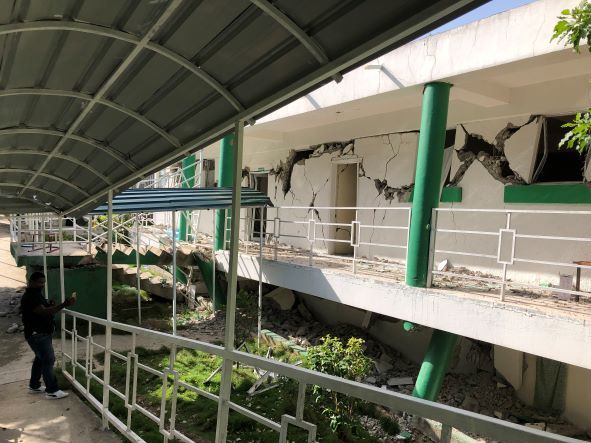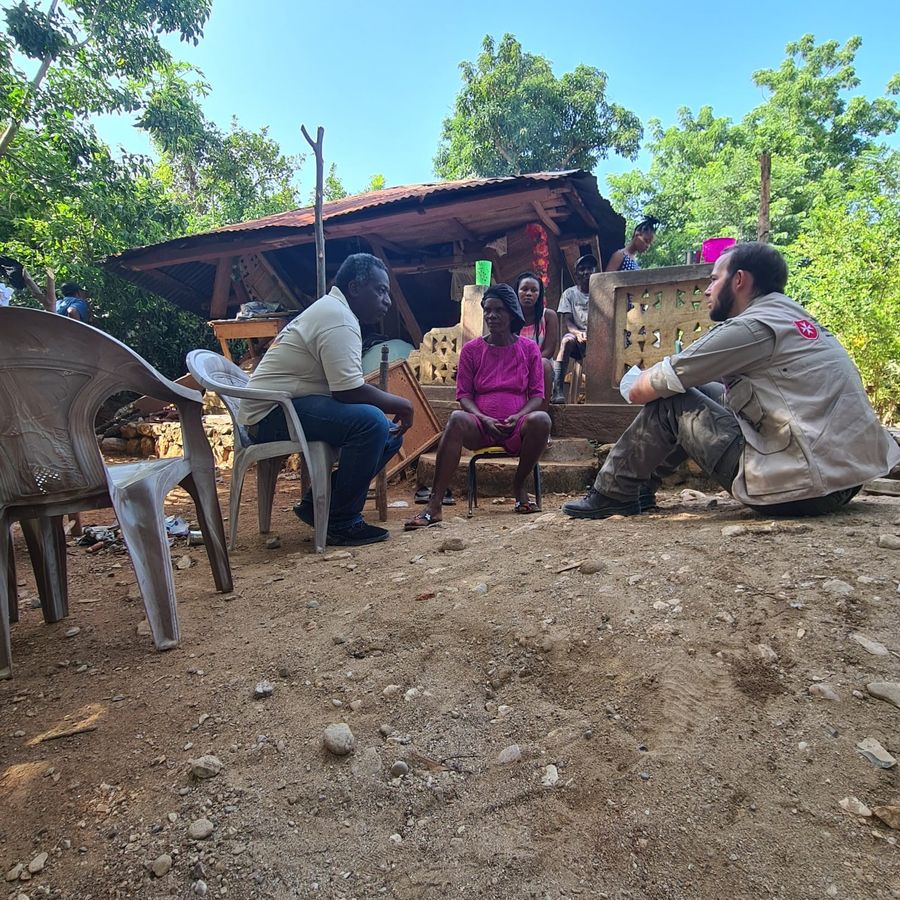
After the earthquake: "Buildings, roads, water and sewage systems - everything was gone.“

"From above, looking out of the plane, I thought: Why are we here, it is not even looking too bad. But the moment we landed and the closer we got to the epicentre, the more massive the damage got. I would say that in some places up to 90 percent of the buildings were in complete ruin," says Toni Gärtner, Malteser International's emergency relief expert.
On the morning of the 14th of August, Haiti was shaken by a severe earthquake with a magnitude of 7.2. More than 2,200 people lost their lives, and about half a million people are since then in need of additional aid. Just a few days after the earthquake, a tropical storm swept over the affected area. In August, Toni Gärtner travelled to the crisis region himself to support the Malteser team on site and to determine the exact needs for acute emergency aid: "On site, we were presented with a catastrophic picture. The infrastructure alone: buildings, roads, water and sewage systems - everything was gone."
The earthquake hit particularly hard in the department of Nippes, about 150 kilometres from the capital Port-au-Prince. For many years this region has been in the focus of the Malteser International's projects there. Through the country office, urgently needed aid could immediately be brought to the people. "The fact that we were able to help so quickly on the ground is not a matter of course. The security situation in the country is extremely tense, it was not easy to get to the affected region," reports Gärtner.
Reconstruction setbacks again and again

At the time of the storm Malteser International was distributing tarpaulins, as well as food and cash for the affected so that they were able to provide themselves with what they most need. Additionally, three health facilities were promptly equipped with new supplies and medicines. "We saw many destroyed hospitals and health posts - easy to recognise as they are painted green and white in Haiti. Many of these facilities still looked new, having been built only a few years ago. And now everything is just gone."
The aid workers are not discouraged by this: "We have been working with the people in the region for years and are ready to help them with the rebuilding of five schools and three health facilities. We will also focus on immediate reparation of the water supply system, since it is urgently needed right now, as well as continue with cash aid“, Gärtner explains. Rebuilding the devastated region will be difficult: in Haiti, building a house costs between 15,000 and 18,000 dollars and can take between ten to 15 years.
The new earthquake is only one of many setbacks for the people of Haiti. The last time a massive earthquake hit the capital Port-au-Prince, was in 2010, when 200,000 people lost their lives. Also the ever reoccuring tropical storms, mean repeated set-backs for the reconstruction works in the desperately poor caribbean country. A country with a permanent political crisis and with more than half of its inhabitants living below the poverty line. Hunger is a daily problem; already before the recent earthquake had happened, about 4.4 million people were living dependent on aid. "It is very grounding to see how people deal with this situation, which seems hopeless to outsiders," reports Gärtner. "They don’t look back, they continue: What else can we do than keep rebuilding?“
"For the people, it is particularly hard that, in addition to the houses and infrastructure, important cultural monuments have also been destroyed."
Interview: Toni Gärtner in detail on the emergency relief mission in Haiti

As an emergency aid officer: What is the process of such a mission in a crisis area and how does one prepare for it?
We are involved in corresponding networks worldwide and usually find out very quickly via an alarm system when and where a disaster occurs. Then the first thing is to assess the situation: What is the situation on the ground? Will international help be requested? How can we help? The decision on an operation is made in consultation with all departments concerned and the management sector of Malteser International. Then we put together a team suitable for the respective mission. At Malteser International, we have a so-called "Pool of Experts", i.e. volunteer experts with different competences who regularly train for such a mission and can be requested in case of a crisis.
You flew to Haiti together with a colleague from the "Pool of Experts". How did this team constellation come about?
In Haiti, we have a country office who just few days after the disaster was able to provide immediate aid. But, due to the scale of the disaster, our colleagues on the ground requested additional support, particularly for the application process and the assessment of needs. My colleague Bernd Körber from our "Pool of Experts" has great experience in this area. However, due to the security situation in Haiti, it was not an option to send a team of just volunteers, hence the decision to send me with the team as I am a permanent member of staff.
After the earthquake in 2010, there was massive criticism, especially about the lack of coordination of international aid: How did you experience this mission?
I wasn't on the ground in 2010, but from what I've heard, the coordination went better this time than in 2010. But there were occasions where the feedback we needed did not arrive on time, which lost us a lot of productive time, that was very frustrating. But you can‘t expect too much: Haiti is a country with very few resources anyway, and even this summer with the flood disaster in Germany we saw, a country with completely different financial possibilities, that not everything can work smoothly not even in the event of a disaster.
What impressed you most on site and how do you deal with the experiences the moment you go back to everyday life?
It is part of the whole process that Malteser International carefully prepares and follows up on the missions, always with the availability of professional support for the processing of severe experiences. I was particularly impressed by the conversations with the colleagues on site, who told me a lot about the culture of the Haitians. For many of them, it is especially hard that, apart from the houses and the infrastructure, important cultural monuments too were destroyed by the earthquake.
Info: Malteser International in Haiti
Since the earthquake in 2010 Malteser International has been a present helping figure in Haiti. The team is since based in the capital Port-au-Prince with projects in Petit Trou des Nippes, Baradères, Cité Soleil and Belle Anse. The aim of Malteser International's work is to continuously develop the country’s infrastructure and to provide the people with sustainable income opportunities and thus a stable livelihood.
In the past eleven years, the staff of Malteser International has among other things, rebuilt schools, a health centre and sanitation facilities, all earthquake-proof. With the aim of promoting the population‘s nutritional independence they are planting kitchen gardens and in addition work on the reforestation of the mangrove woods.
October 2021








